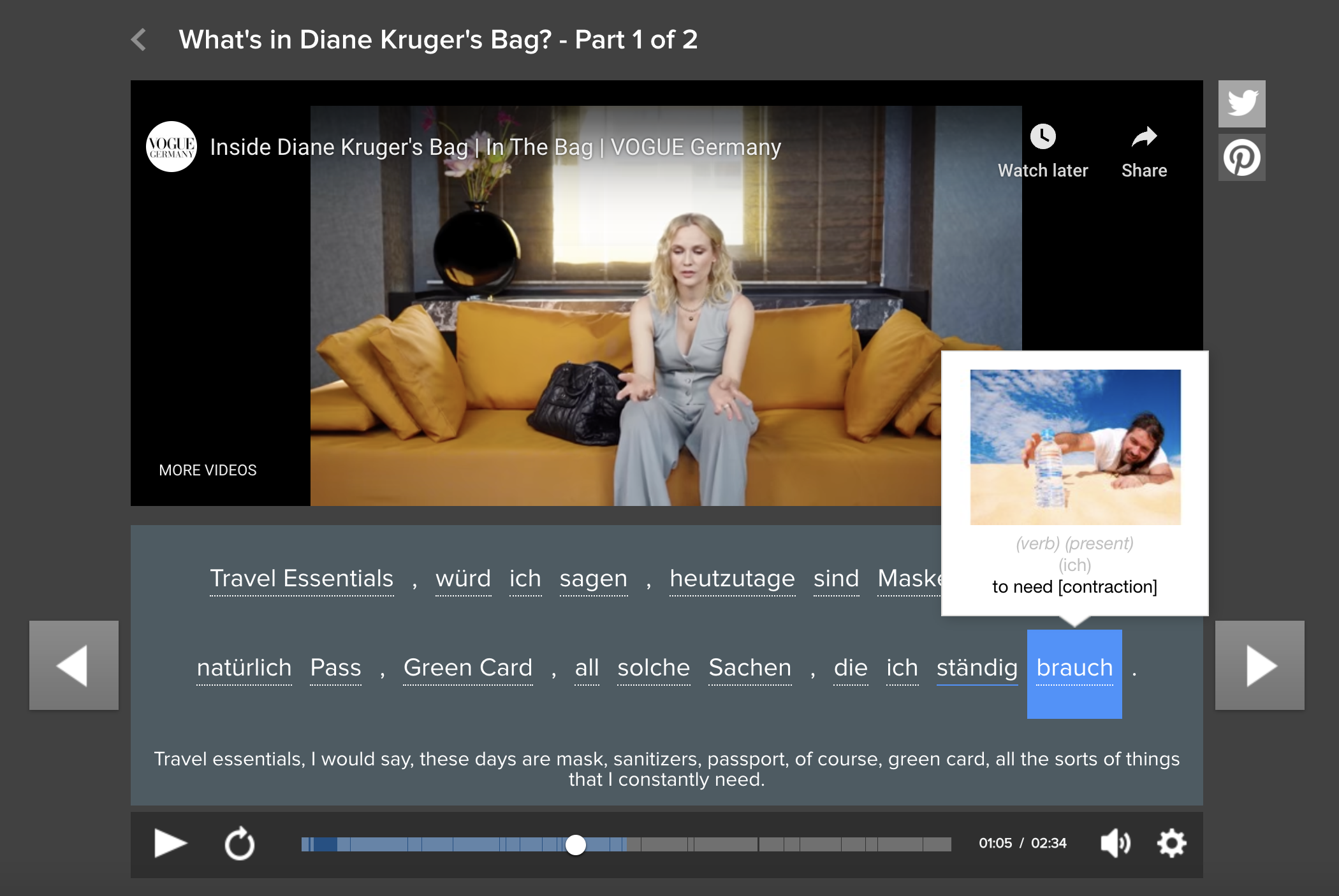
Learn German Through Shadowing
German can be a tricky language to master, but using the shadowing technique can help your brain learn the patterns of the language a lot quicker than basic repetitions.
Shadowing is a method for learning a language that works your muscle memory to get you fluent faster.
Today, we’ll talk more about shadowing and resources that you can use to learn with it.
Contents
- What Exactly Is “Shadowing”?
- What Are the Benefits of Shadowing?
- How to Do German Shadowing Step-by-step
- German Shadowing Resources to Get Fluent Faster
Download: This blog post is available as a convenient and portable PDF that you can take anywhere. Click here to get a copy. (Download)
What Exactly Is “Shadowing”?
“Shadowing” is a language-learning technique developed by the American language professor Alexander Arguelles.
It entails listening to a German passage and trying to speak the words at the same time as the speaker says them. The idea is to get used to the sounds and feelings of speaking another language, until they become second nature.
Arguelles figured out that if you “shadow” words in another language enough times, the sounds begin to stick in your head.
After all, it’s basically the way we learned our first language. Filter out all that ga-ga goo-goo in the first few years and once you start talking as a kid, it’s not easy to stop. Kids want to repeat everything they hear—no matter if it’s good or bad. (And kids just say the darndest things.)
The idea with shadowing is to use audio or video clips in a language you want to learn and mimic the noises you hear. It’s not so much about getting the words exactly right or comprehending what’s being said. Your focus should be centered upon moving your mouth in such a way that you echo what you hear.
Arguelles separated his technique of shadowing into two levels: beginner and advanced. These classifications center upon your language skills and the length of the audio scripts. Beginner shadowing uses short scripts of just a few minutes. As you might’ve guessed, advanced shadowing requires longer scripts, such as German audiobooks, movies and podcasts.
Shadowing is a technique that works best when combined with a regular study routine. So if you’re tired of flipping through flashcards or doing grammar drills, shadowing can be a fun yet efficient addition.
What Are the Benefits of Shadowing?
Now that you know a bit more about what shadowing is, let’s talk about what you’ll gain by including this technique in your German practice.
- At the most basic level, shadowing helps you to practice speaking the language. The more you voice the language aloud, the stronger the bond between your senses and the language itself.
- Shadowing presents you with opportunities to learn new words. Not only will this increase your vocabulary, but you’ll be introduced to the word as it sounds, not necessarily as it looks. Oftentimes, this association forms a much stronger bond between the word and its meaning, especially for those who learn by physical means, rather than visual.
- Shadowing is great for working on your accent and intonation, as well as mastering colloquial German speech. As you listen to the audio you’ve chosen to shadow, you’ll begin to pick up the rhythm of speech. Grammar, usage and mechanics rank low compared to the way you’re interacting with the language on an audible level.
But take a note of caution here: the audio you use should be accurate. Shadowing is of no use to your language learning if you’re repeating inaccurate words and phrases.
That’s why we’ve put together a list of resources you can trust when it comes to trying out this shadowing technique. Stay tuned for more on that in a minute.
How to Do German Shadowing Step-by-step
To take full advantage of the benefits of shadowing, there are a few things to keep in mind.
- The first step is to gather a number of audio resources on various topics. As we mentioned, these resources should be accurate and represent grammatical German.
- No matter what level of German fluency you’ve attained so far, you should begin with short scripts. As you progress through your studies, you can easily ramp up the difficulty of your shadowing technique.
- Next, pick a time each day to practice. You should aim to shadow as much as possible, since repetition is the key element. Take a few minutes before school or work, or even right before bedtime.
- Focus on listening to the script and repeating what you hear. Move your mouth deliberately and take it to the extreme if you have to. It may feel a bit odd at first, but remember the way little kids speak? Words don’t often come out perfect but we still get the message.
- Pause. Rewind. Repeat. Listen to your shadowing scripts a few times, to the point where you can recite them if need be.
- Then, move on to another song, podcast, movie or audiobook. The beauty of shadowing is that you’re only limited by the number of scripts you can come up with.
German Shadowing Resources to Get Fluent Faster
Consider the following resources a beginner’s guide to shadowing, at least for German learners. Feel free to bookmark the audio you like and search out your own scripts that’ll have you looking forward to learning German and ultimately obtaining fluency.
1. Radio D Podcast
Resources such as podcasts are huge for language learners. This is especially true for shadowing. Part talk show, part educational resource, podcasts allow us to make use of downtime while still including an element of fun.
To demonstrate, let’s take a few examples from Radio D, a German podcast for beginners. Hosted by reporters Paula and Philipp, these 10-15 minute podcasts center around a specific situation, like chapters in a book. Each one builds on the previous episode and there are 26 episodes in the first season and 26 more episodes in the second.
How to Use Radio D Podcast Episodes as a Shadowing Resource
For great shadowing practice, don’t just listen to the podcast. Find the PDF transcript by clicking on each episode link in iTunes and then clicking on “Episode Website.” You can use this to follow along with the text. You’ll also find some grammar and listening exercises (and yes, solutions as well) which you can use to check your comprehension.
To get the most out of these podcasts in terms of shadowing, keep a few things in mind. Shadowing emphasizes repeating words you hear, but listen to the sounds of the podcast as well, especially in Radio D which has great sound design. What audio cues can you pick up that act as context clues for what’s going on?
Also, note intonation. This includes emphasis on certain words or even syllables of a word. In the very first episode of Radio D’s series, you’ll hear the male character say “Hallo” (“Hello”) twice, each time with a different intonation. The first time is a bit quizzical, and the second time seems to request a response. You’d be surprised how much information you can pick up just through intonation, even if you didn’t know a single word in the language of the speaker.
Shadow as much German as you can, using the transcript when you need to, and feel free to skip back a few seconds to shadow words of choice multiple times. If you feel like you didn’t understand an episode enough to summarize it to a friend, listen to it again, practicing your shadowing once more as well.
2. German Audiobooks
Curling up with a good book works great on rainy days and sleepless nights, but audiobooks allow you to take your literature practically anywhere. These spoken-aloud stories can also be a huge resource when it comes to learning a new language, such as German.
You can hear the story spoken aloud, usually by native speakers, and follow along with the storyline as if it were happening in the next room over. Sound effects and character voices certainly make the experience a memorable one as well. If it’s a familiar story and you happen to know the plot beforehand, it can also open up the door to a focus on shadowing, rather than comprehension.
You can find German audiobooks in a variety of places online. Many are available from Amazon, such as “Der Wald.” Others, like this audiobook series from BookBox, can be found on YouTube to watch and listen to for free.
Check for German versions of your favorite audiobooks wherever you get your English audiobooks from.
How to Use Audio Stories on YouTube as a Shadowing Resource
To adapt German audiobooks into a shadowing resource, voice the story aloud as it happens and follow along with a print version. If you’re following along with an audio story on YouTube, you can also read the subtitles.
Let’s use the first episode of the BookBox series to demonstrate. Entitled “Der größte Schatz” (“The Greatest Treasure”), this first YouTube video in the series follows Peter as he finds eine Schatzkarte (“a treasure map”). You can follow along with the story via the visual storyboard presented. Below the video, you’ll find German subtitles, which you can focus on while you shadow. YouTube also allows you to enable closed captioning, which puts English subtitles onto the video as well.
Once you grasp the meaning, we recommend turning those English subtitles off and focusing your attention to the German words. When the speaker pauses, take in the pictures you see, frame by frame. Many of the characters’ faces give away contextual clues. You can also skip forward and back as often as you please with YouTube videos, so be sure to take advantage of that capability as well.
3. German YouTube Videos: “Fritten zum Mittag”
Speaking of YouTube videos, we’d like to introduce you to “Fritten zum Mittag.” This short comedy film, entitled “French Fries for Lunch,” is about 18 minutes long. Following the story of a Frittenfrau, or frying girl, this skit will resonate with anyone who’s ever dated.
This isn’t necessarily a video we’d recommend for beginners (or for younger audiences, given some of the adult content), but if you’re looking for authentic German spoken by native speakers in a real-life situation, “Fritten zum Mittag” should be on your list.
How to Use YouTube Videos as a Shadowing Resource
German videos such as “Fritten zum Mittag” require a bit more experience with shadowing. In fact, we recommend you gain confidence in the method of shadowing before you use this resource to practice the technique. However, there are a lot of elements that make “Fritten zum Mittag” a good candidate for shadowing.
While the speakers definitely talk in a faster, more natural way, this is authentic German. Since the interactions between the characters are central to the plot, there’s much you can pick up from body language, facial expressions and inflection.
To get the most out of this particular video, watch it all the way through once without shadowing. This will allow you to simply hear the language and watch the action. Then, work the entire video scene by scene. Watch the main male character flirt with the Frittenfrau after he hangs up with his girlfriend and then get turned down with his money thrown back in his face. Shadow that scene until you feel comfortable, and then move on to the next.
In general, this is a good technique to use when working with longer or more advanced videos. Watching the whole thing once can avoid frustration and can make shadowing more enjoyable overall.
While you’re doing your initial watch, you can enable German or English subtitles to pick up on some of the colloquial phrasing used. When you see a phrase you want to memorize and use in your own speech, replay that scene to practice shadowing how it’s said. Adding these phrasings to your vocabulary toolbox puts you one step closer to fluency.
4. Audio and Visual Resources from FluentU
FluentU is an immersive program that turns video clips from authentic German media into personalized language lessons.
It’s an excellent resource for shadowing because every video clip comes with subtitles in German and English which you can toggle on and off as needed. You can also download a transcript to easily follow along with the dialogue.

Since the videos are made by and for native speakers, you can be sure that you’re shadowing the language as it’s actually used in real life. And you won’t get overwhelmed or bored with the short clips like you might with longer audio or videos.
With an expansive library and new videos being added all the time, you’ll have plenty of content to shadow with FluentU.
How to Use FluentU as a Shadowing Resource
All you have to do is pick a video that looks interesting and apply your shadowing techniques to it. Whether it’s a movie, song, short video clip or even an interview with just audio, you can shadow it.
For instance, let’s say you choose a film clip. Before you begin, read the included transcript, then turn on just German subtitles. As you watch the words on the screen, shadow what you hear. If you get hung up on a particular part of the video, you can use the arrows on the video player to repeat a section.
5. MosaLingua App
The MosaLingua app for German is something you can easily download on your phone. You’ll have to pay a small monthly fee to obtain the software, but it’s not much more than a Starbucks visit. Call it investing in your future, because this resource contains a jackpot of audio resources perfect for shadowing.
The MosaLingua app contains over 50 dialogues spoken by native speakers. Subjects range from socializing and emergencies to going out and asking for help. Unlimited access also comes with the option to tailor your learning with additional resources that can be purchased in the app as well.
How to Use MosaLingua as a Shadowing Resource
To get the most out of MosaLingua, we recommend using it as a supplement to your study routine. You don’t need an internet connection to use the app, so it’s great for small increments of downtime. Practice shadowing on your walk to work or during a car trip, or even right before you go to sleep.
Another part of the MosaLingua app that you should take full advantage of are the miniature tests given for comprehension. Though you’ll want to focus more on listening to the audio and shadowing what’s said, it’s always a good idea to check if you’ve understood what you’ve heard. Doing poorly on the test indicates it might be a good idea to go back to the audio you’ve just heard, and listen to—and shadow—the clip a few more times.
6. Schoener Fernsehen: Authentic German TV
We all love kicking back and watching some TV. After all, our bodies get to rest from the day and yet our minds are transported to places we’ve never been before. You may think watching TV in German would be more chore than fun, but have you checked out Schoener Fernsehen?
Schoener Fernsehen compiles a variety of German TV channels into one streaming service. In fact, you can watch live German TV, along with private channels as well. Again, like many of the resources listed here, it’s real German, the same stuff you’d see and hear if you were at home in Munich.
Did we mention it’s free? Okay, so technically most of Schoener Fernsehen is free. There are a few channels you do have to pay for. It’s a bit like signing up for Netflix or Hulu, where the premium content comes once you’ve subscribed to the service.
That being said, how would you like to watch some of your favorite shows in German? This is where the freedom of shadowing shines. You can pick movies and shows you’ve already seen or have watched in English and shadow along with the episodes. Like your favorite book, it’s a plotline and story you can follow along with, except you’re looking at it through the lens of the German language instead.
There are plenty of real German shows to choose from as well. If you’re looking for a new show to get sucked into, Schoener Fernsehen has plenty of those.
How to Use German TV as a Shadowing Resource
For shadowing, we suggest starting out with a show you’re familiar with. Beginners will find it easier to apply the shadowing technique that way. However, once you’ve practiced shadowing a few times, pick a new German show and try to shadow as much as you can.
Getting the most out of Schoener Fernsehen lies in the ability to pause the show as it plays. You won’t be able to back the film up in most cases, but you can stop the action and write down words or phrases you don’t know for future study. When an episode is over, try to summarize what you’ve seen, even if you don’t know the whole plot. You can always go online and research the series to figure out how accurate you are.
Available subjects on Schoener Fernsehen include news, entertainment, cartoons, crime shows, history, action and pretty much anything else you’d be able to find on an English streaming service. So make the best of your TV-watching time with Schoener Fernsehen and some German shadowing.
7. “Einmal Um die Welt” and Other Contemporary German Songs
Surrounding yourself with the language includes playing German songs as well. But that doesn’t mean you’re stuck with just the oldies like “99 Luftballons” either. We admit, there’s nothing wrong with the classics, but if you’re looking for contemporary German songs, there are plenty out there.
One of those songs is “Einmal Um die Welt” by Cro. Centered around companionship and wanting to give a loved one a trip anywhere around the world, this song is upbeat. It’s something you can easily play in the car or have queued in your playlist. Best of all, you don’t have to have any special subscription to stream it. The song is free on YouTube to listen to at any time.
How to Use German Songs as a Shadowing Resource
There are certain components that make a song unique from a movie or short clip. For instance, you’ve got a melody and lyrics to go along with it. The music behind the words can play as big a part as what the speaker conveys with the lyrics.
The majority of the time, lyrics of a song are written with colloquial terms and phrases. That means any shadowing you do should help you build up those types of vocabulary within your studies. Choruses allow you multiple opportunities to practice the same phrases. As we know, practice and repetition are key components of the shadowing technique. Finally, you can listen to songs over and over again and they’re catchy enough to memorize with ease.
In the case of “Einmal Um die Welt,” you can easily listen to the song and shadow at the same time. We encourage you to listen to the song first and watch the music video to have visual context. Then, listen to “Einmal Um die Welt” again, but with the German lyrics in front of you; printed out is best.
Doing this a few times will help your mind associate the sounds you hear and voice aloud with the words upon the page. If you’d like to check your comprehension, the English translation will guide you towards the meaning.
We hope you’ve been able to see how easy it is to implement shadowing into your language-learning journey. Learning a foreign language takes effort, but with the shadowing technique, fluency becomes more attainable each time you practice.
There’s practically no end to the resources available for shadowing. You can customize them how you want and best of all, make them work for you! Shadowing is a great way to work smarter—not harder—and make language learning fun.
Download: This blog post is available as a convenient and portable PDF that you can take anywhere. Click here to get a copy. (Download)





